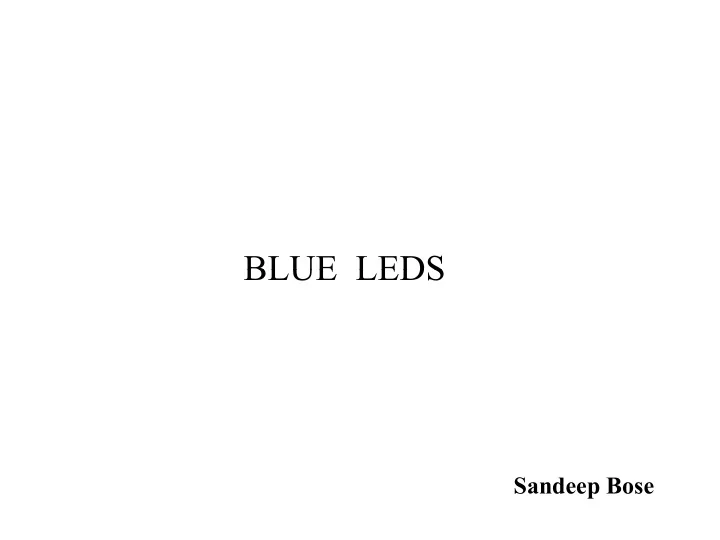

BLUE LEDS BLUE LEDS Sandeep Bose
What is LED A light-emitting diode (LED) is a semiconductor device that emits light when an electric current is passed through it. An LED may contain several layers of semiconducting materials . Principle
The lights wavelength depends entirely on the semiconducting materials used. The material used for for the production of blue LED is GaN. The band gap of GaN is 3.4eV. History The first report of light being emitted from a semiconductor was authored in 1907 by Henry J. Round, a co-worker of Guglielmo Marconi, Nobel Prize Laureate 1909. Soviet inventor Oleg Losev reported creation of the first LED in 1927. Kurt Lehovec, Carl Accardo and Edward Jamgochian, explained these first light-emitting diodes in 1951 using an apparatus employing SiC crystals with a current source of battery or pulse generator. or pulse generator. In 1950s scientists have prepared the first red LED. In late 1960s first green LED was prepared. Why Blue LED
Problem of getting blue LED (i) The main problem was the preparation high quality GaN crystal. (ii)It is virtually impossible to create a p-type layer in the material. It took almost 30 years to solve this problem. How they finally achieve it In 1986, Akasaki and Amano were the first to succeed in creating a high-quality gallium In 1986, Akasaki and Amano were the first to succeed in creating a high-quality gallium nitride crystal by placing a layer of aluminium nitride on a sapphire substrate and then growing the high quality gallium nitride on top of it. Nakamura began developing his blue LED in 1988. Two years later, he too, succeeded in creating high-quality gallium nitride. He found his own way of creating the crystal by first growing a thin layer of gallium nitride at low temperature, and growing subsequent layers at a higher temperature.
By coincidence Akasaki and Amano discovered that their material was glowing more intensely when it was studied in a scanning electron microscope. This suggested that the electronic beam from the microscope was making the p-type layer more efficient. Nakamura could also explain why Akasaki and Amano had succeeded with their p-type layer: the electron beam removed the hydrogen that was preventing the p-type layer to form. For his part, Nakamura replaced the electron beam with a simpler and cheaper method: by heating the material he managed to create a functional p-type layer in 1992. method: by heating the material he managed to create a functional p-type layer in 1992. To make it more efficient alloys of GaN have prepared by adding Al, In into it. Finally, in 1994, it is commercially available.
Advantage With white LED light, companies are able to create smartphone and computer screens, as well as the flash lights. It is used for the generation of blue laser . It is used for making white LED light bulb. A modern white LED light bulb converts more than 50 percent of the electricity it uses A modern white LED light bulb converts more than 50 percent of the electricity it uses into light. Compare that to the 4 percent conversion rate for incandescent bulbs, and you have one efficient bulb. In the LED, electricity is directly converted into light particles, photons, leading to efficiency gains compared to other light sources where most of the electricity is converted to heat and only a small amount into light. In incandescent bulbs, as well as in halogen lamps, electric current is used to heat a wire filament, making it glow. In fluorescent lamps a gas discharge is produced creating both heat and light .
The most recent record is just over 300 lumen/watt, which can be compared to 16 for regular light bulbs and close to 70 for fluorescent lamps. As about one fourth of world electricity consumption is used for lighting purpose. The use of energy-efficient LED will reduce it to 4% of the total electricity consumption for lighting. It has longer lifetime than CFLs, incandescent lamp .
Isamu Akasaki Hiroshi Amano Shuji Nakamura
Recommend
More recommend